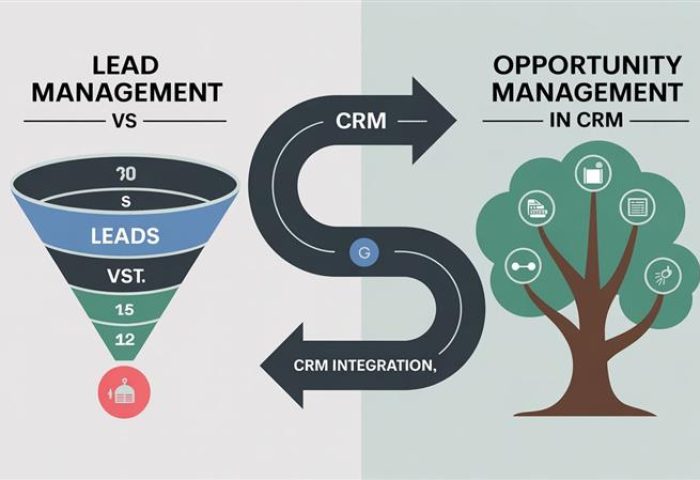In today’s competitive sales environment, companies can no longer treat all potential customers equally. CRM (Customer Relationship Management) software now accommodates two essential but discrete processes: Lead Management and Opportunity Management.
Though frequently interchanged, these two functions correspond to different phases in the customer experience. Knowing the difference—and making strategic use of both—can enormously enhance conversion rates, customer experience, and sales forecasting.
In this blog, we’ll explore what Lead Management and Opportunity Management are, how they differ, and why both are essential in a modern CRM system.
What Is Lead Management?
Lead Management is the process of capturing, tracking, nurturing, and qualifying potential customers (leads) before they are sales-ready. Leads are typically people or businesses interested in your product or service but have not engaged in formal negotiations with your sales department.
Key Steps of Lead Management:
- Lead Capture: Get leads from various sources – web forms, ads, events, emails, social, etc.
- Lead Scoring: Assign value based on their behaviour (opens, clicks), demographics (location, title), or source (paid ad, referral).
- Lead Nurturing: Follow up with emails, newsletters, and helpful content to build leads’ interest.
- Lead Qualification: Determining whether a lead is a good fit, and is ready to take action – generally based on budget, authority, need, and timeline (BANT).
The goal of Lead Management is to eliminate contacts with no interest in your offering and focus only on the best prospects.
What Is Opportunity Management?
Opportunity Management begins when a lead is “sales-qualified” and actively considering your offer, and they become an opportunity in the pipeline. This is the stage where we are examining all of the activities, interactions, and negotiations that lead the deal closer to closing.
Most Important Stages in Opportunity Management:
- Deal Creation: Adding a prospective deal with an estimated value, predicted close date, and assigned sales rep.
- Pipeline Tracking: Tracking progress through phases such as proposal, demo, negotiation, and contract review.
- Forecasting & Reporting: Forecasting revenue per deal stage and conversion history.
- Win/Loss Analysis: Understanding why we win or lose deals to improve our ability to win deals going forward.
The ultimate aim of Opportunity Management is to take a qualified opportunity and convert it into a purchasing customer most efficiently and smartly.
Key Differences: Lead Management vs. Opportunity Management
| Aspect | Lead Management | Opportunity Management |
| Stage | Pre-sales qualification | Active sales process |
| Focus | Filtering & nurturing leads | Closing deals |
| Goal | Identify sales-ready prospects | Win business |
| Ownership | Marketing & SDR teams | Sales team |
| CRM Features | Forms, scoring, email campaigns | Deal stages, value tracking, forecasting |
Why Both Are Important in CRM?
Organizations that focus on only one of these processes will be stuck in “pipeline gaps”. You need Lead Management to fill your funnel with quality prospects—and Opportunity Management to close them out.
Here’s why having both together is essential:
Improved Sales-Marketing Alignment
Lead Management enables the right leads to be passed on to sales by marketing teams.
Opportunity Management ensures that those leads are managed effectively once transferred.
Better Forecasting
When lead and opportunity are distinguished, CRM reporting improves. You are able to forecast revenue from the deals, whereas lead generation and conversion rates can be measured independently.
Targeted Selling Efforts
Sales representatives won’t waste time chasing down unqualified leads. They will only work on opportunities that are likely to close.
Higher Conversion Rates
Lead nurturing increases engagement before the sales team gets involved. As a result, when leads enter the pipeline, there is a greater opportunity to convert and close a deal.
When should you move a lead to an Opportunity?
You may be wondering when to change from Lead Management to Opportunity Management as part of your CRM workflow. The perfect time to change will be after any of the following:
- The lead asks for a quote or demo indicating they are ready to make a purchase
- The lead mentions a budget or timeline
- You know the decision-maker is involved
- The sales team has acknowledged the lead is qualified
- Once one of these conditions is met, you will create a new opportunity in your CRM and begin tracking the deal.
How Does DoInsights Manage It?
Modern CRM systems like DoInsights allow organizations to manage leads and opportunities in a single dashboard. Salespeople can:
- Score and qualify leads
- Convert qualified leads to opportunities with ease
- Track the progress of their pipeline management and forecast revenue
- Set reminders and automate follow-ups
This organized way of managing leads and opportunities ensures no leads go to waste and all opportunities are nurtured to the fullest—especially useful as the dual management of leads and opportunities is growing in business in Germany, the UAE, and internationally.
Conclusion
Understanding the difference between Lead Management and Opportunity Management is important for effective high-performing sales processes. One helps you fill the funnel with prospective customers, while the other helps you make sure you get the deal done! When combined in a smart CRM, they automate marketing and sales collaboration, eliminate manual effort, and enhance revenue visibility. See how the two functions complement each other in one easy-to-use CRM platform. Take a demo of DoInsights today and discover smarter sales management.


